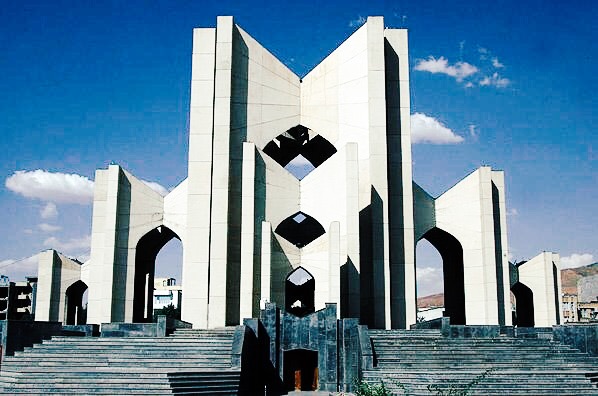Mystics, scholars, poets — it seems that all of Iran’s esteemed creatives end up at the Maqbaratol Shoara mausoleum, otherwise known as “The Tomb of Poets.” The mausoleum has welcomed everyone from Asadi Tusi (in 1079), the very father of the Persian language, to the country’s beloved tragic poet Seyyed Mohammad Hossein Behjat-Tabrizi (1906-1988).
Located in the Surkhab district of Tabriz in Iran, the mausoleum boasts a beautiful design that is both modern and Moorish. Its pronounced arches and thick geometric elements create a clean, imposing presence while making a nod to traditional elements of Iranian design. The building materials are simple, even austere. Inside, decorative blue tiles grace the walls, but the outside of the mausoleum is a concrete-gray. The sky is visible through the star shaped “cutouts” of the ceiling. The light falls through, spilling onto the floor in ethereal mosaics. The building was erected in the mid-seventies, but it adopts a kind of timelessness.
“The light falls through, spilling onto the floor in ethereal mosaics. The building was erected in the mid-seventies, but it adopts a kind of timelessness.”
“There’s more than 400 poets buried here,” said one visitor about his trip to the Tomb of Poets, “[covering] over 800 years of history.” Another woman described her visit by saying that the mausoleum is actually “a [good] place for meditation visited by many poetry lovers from Iran and abroad. It offers a good opportunity to get acquainted with the most important personalities of Persian literature and their poetic work from different centuries. There is nothing macabre out of this collective tomb, on the contrary — it is a place of joy…”
“Your shoulders are–
sheltering, proud rocks.
In their slant, crawl–
the lightly shower of my locks!Your shoulders are–
The atrium to a majestic tower.
At its gate, dance–
The cheerful chains of my hair!Your shoulders glow–
Under the golden storm of sunshine,
Beneath the silver rain of sweat.
Your shoulders are–
To my supplicant eyes a shrine,
The altar where– my prayer’s met.”— a poem by Forough Farrokhzad (1935–1967) entitled, “Your Shoulders”
That’s the wonderful thing about the Tomb of Poets: it has gathered all those writers and thinkers who strove to create beauty in their work and created an everlasting homage to their pursuits. And what better way to foster a sense of cultural respect for the arts?

 The Tomb of Poets in Maqbaratol Shoara, Iran
The Tomb of Poets in Maqbaratol Shoara, Iran





 Debating Medical Aid in Dying
Debating Medical Aid in Dying
 “Help Me, Helen”
“Help Me, Helen”















